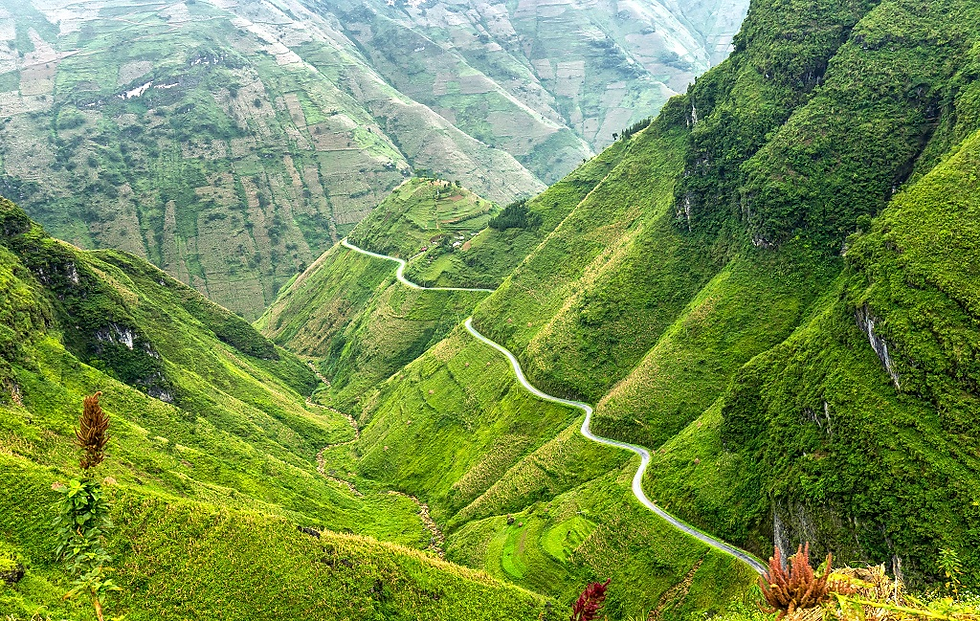Ha Giang Weather in February: Climate Guide & Best Things to Do
- Smiley Phuong

- May 20
- 4 min read
Ha Giang weather in February offers a rare and romantic view of Vietnam’s far north. With cold mountain air, swirling mist, and early spring blossoms, this month delivers both natural beauty and cultural depth. While the chilly temperatures may challenge some travelers, those prepared for the cool climate will find February to be one of the most peaceful and picturesque times to visit Ha Giang.

Temperature and Climate Overview
In February, Ha Giang is firmly in the late winter season, gradually transitioning toward spring by the month’s end. The average temperature ranges from 6°C (43°F) in the early mornings and nights to about 17°C (63°F) in the afternoon. The weather varies depending on altitude; areas such as Dong Van, Meo Vac, and Lung Cu often feel colder and windier due to their higher elevation.
Fog is one of February's defining weather features. Dense morning mist is common, especially along mountain passes and in valleys. The fog often lifts by late morning, giving way to clearer skies and a few hours of soft sunlight in the afternoon. This ever-changing weather adds a mystical charm to the karst mountains and terraced fields.

Rainfall is moderate to light in February. While not considered the rainy season, short drizzles and overcast skies are typical, particularly earlier in the month. As the days progress, the weather starts to become slightly warmer and drier, setting the stage for blooming peach and plum trees.
Humidity stays at a comfortable level—not overly dry or excessively damp—but wind chill in elevated areas can make the air feel colder than it is. For travelers, this means wearing windproof and layered clothing is essential for comfort and safety.
Summary of Ha Giang weather in February:
Temperature: 6°C – 17°C (43°F – 63°F)
Conditions: Foggy mornings, occasional drizzle, cool to cold air
Humidity: Moderate
Sunlight: Limited, often visible during midday
Wind: Present in highland areas, making temperatures feel colder
Scenic Stops to Enjoy in This Weather
February’s cool, foggy weather transforms Ha Giang’s rugged scenery into something serene and dramatic. The weather itself becomes part of the visual experience, with mist flowing through the mountains and crisp air sharpening the silhouettes of stone peaks.
Ma Pi Leng Pass
One of the most breathtaking roads in Vietnam, Ma Pi Leng Pass is especially atmospheric in February. Morning fog blankets the cliffs and canyon, but when it lifts, it reveals a dramatic drop to the jade-colored Nho Que River below. The cooler air also means fewer tourists, so you can enjoy the views in peaceful solitude.

Dong Van Karst Plateau
The UNESCO-recognized Dong Van Karst Plateau takes on a mysterious beauty in February. The limestone formations look hauntingly beautiful under the fog, and the cold enhances the quiet, desolate charm of the landscape. It’s an excellent time for contemplative walks and photography.

Lung Cu Flag Tower
Located at Vietnam’s northernmost point, Lung Cu Flag Tower sits atop a windy hill that offers panoramic views of the border region. The air is crisp, the hike up invigorating, and the visibility—on a clear afternoon—can stretch for miles. It’s a rewarding stop for those seeking both cultural symbolism and scenic beauty.

Highlight Experiences in February’s Climate
February's weather is more than just a backdrop—it. It shapes the kinds of experiences you can have in Ha Giang. The cool temperatures and blossoming landscape open the door to unique seasonal activities.
1. Photograph Early Spring Blossoms
Late February marks the beginning of peach and plum blossom season, especially in villages like Lao Xa, Pa Vi, and parts of Quan Ba. The flowers bloom against a background of grey stone houses and misty mountains, creating a dreamlike setting. Photographers and nature enthusiasts will find this one of the most rewarding times to capture Ha Giang’s natural beauty.

2. Ride the Ha Giang Loop in the Cold
While riding the Ha Giang Loop in February can be chilly, the lack of traffic and ethereal weather makes the experience deeply memorable. The key is to start your rides late in the morning once the fog has lifted and to take your time navigating winding mountain roads. The clear air enhances visibility, and the unique light conditions provide striking scenery at every turn.

3. Experience Ethnic New Year Celebrations
Tet (Vietnamese Lunar New Year) often falls in February. Even after the main holiday, ethnic minorities like the Hmong and Tay continue to celebrate local versions of the New Year with village festivals, market days, and family gatherings. Visitors during this period can witness authentic cultural practices, sample traditional food, and join local celebrations if invited. The cool weather adds a festive, wintery mood to the cultural immersion.

Travel Tips for February
Dress in layers: mornings and nights are cold, but afternoons can warm up. Pack thermals, a windproof jacket, and waterproof gear.
Time your rides: Avoid early-morning starts due to thick fog. Midday travel is safer and offers better views.
Book early around Tết: Transportation and accommodation fill up quickly during the Lunar New Year.
Protect your skin: The air is cold but UV rays are still strong in the mountains—use sunscreen and lip balm.
Visiting Ha Giang in February is a unique and rewarding experience for those willing to embrace the cold. The combination of mystical fog, early spring blossoms, and traditional ethnic celebrations creates a landscape unlike any other in Vietnam. With proper preparation, travelers can enjoy the best time in Ha Giang with stunning scenery, rich culture, and calm atmosphere that make Ha Giang weather February a hidden gem in the travel calendar.



Comments